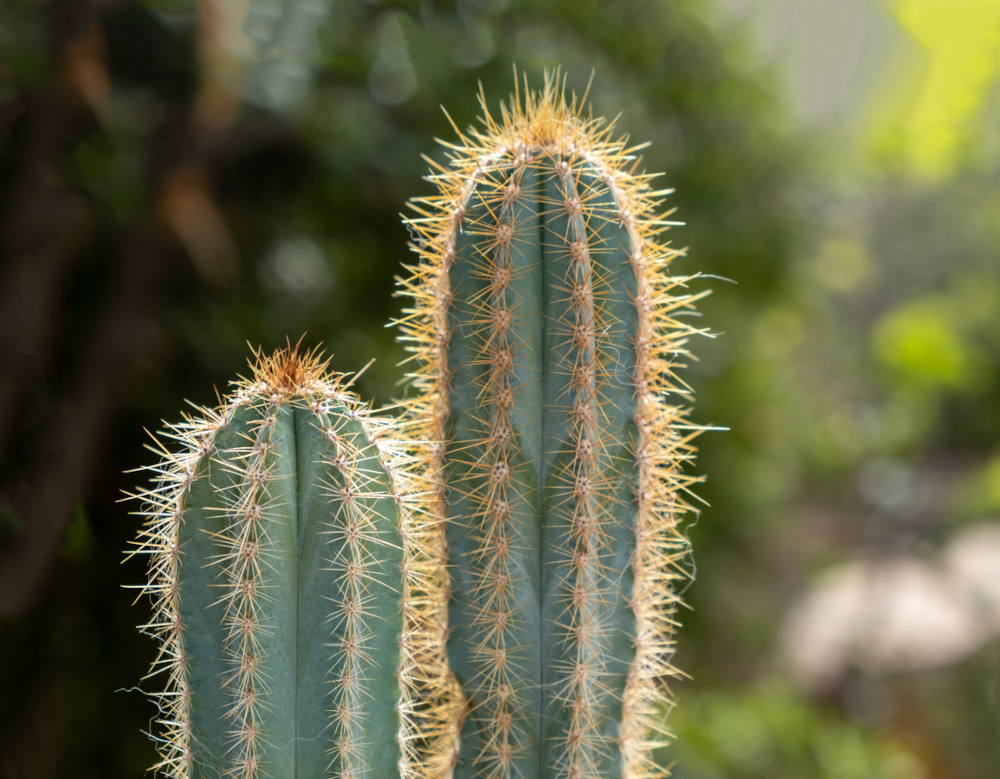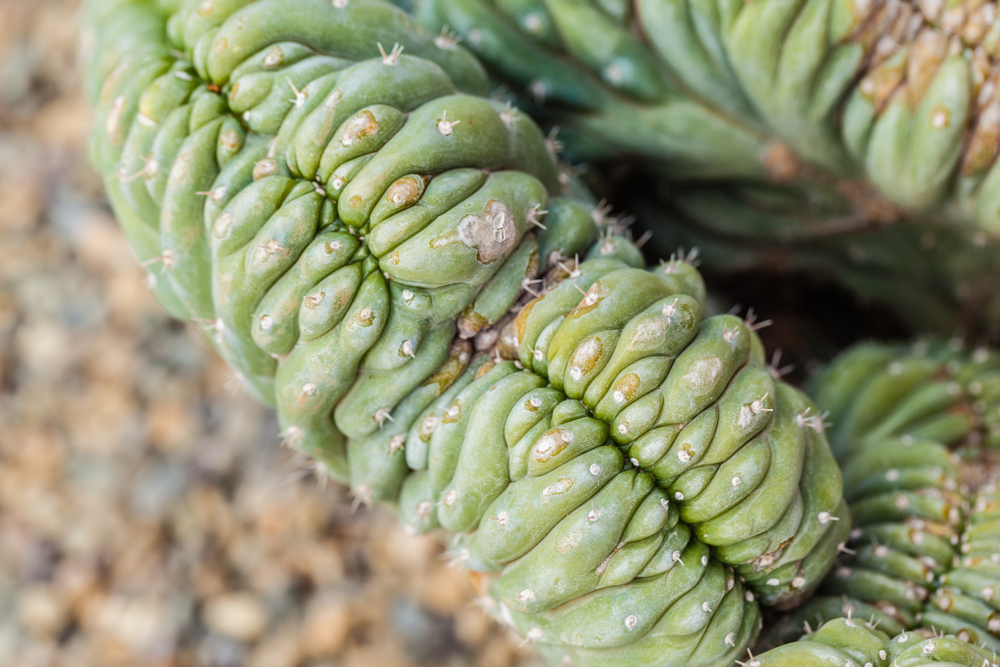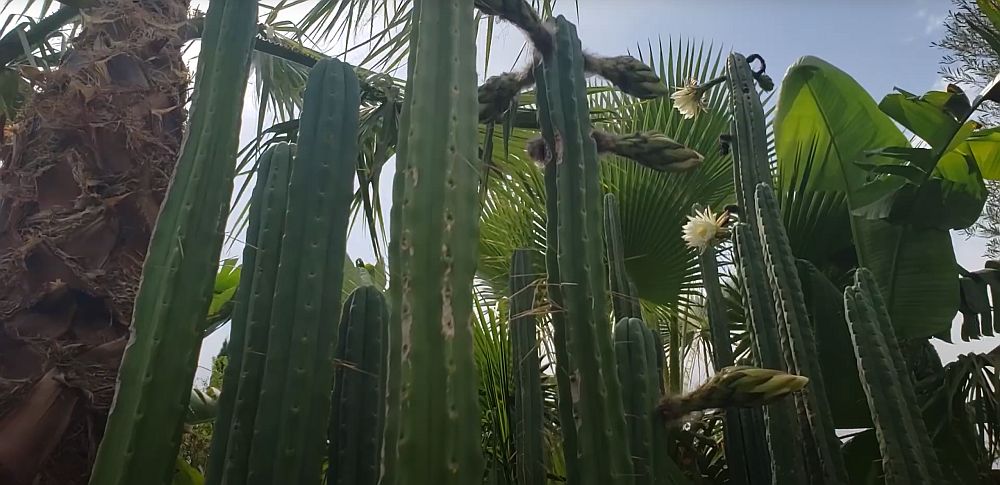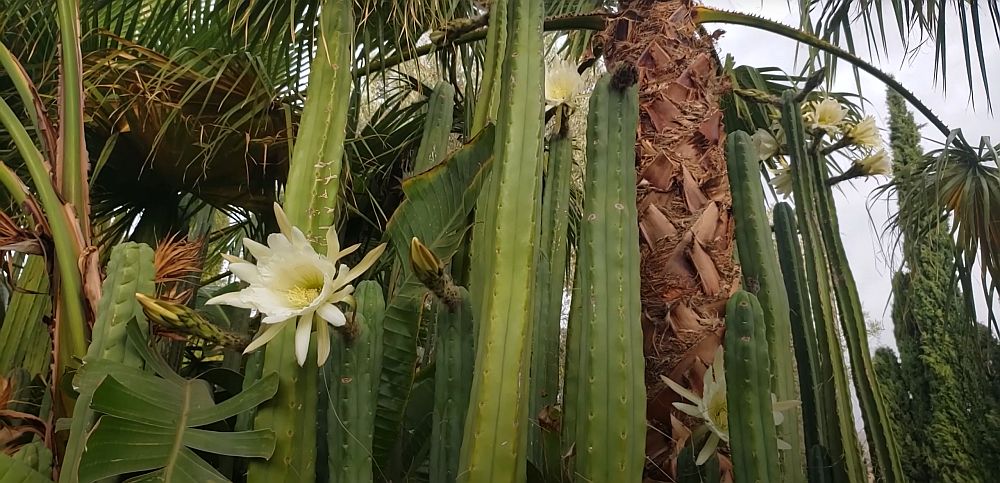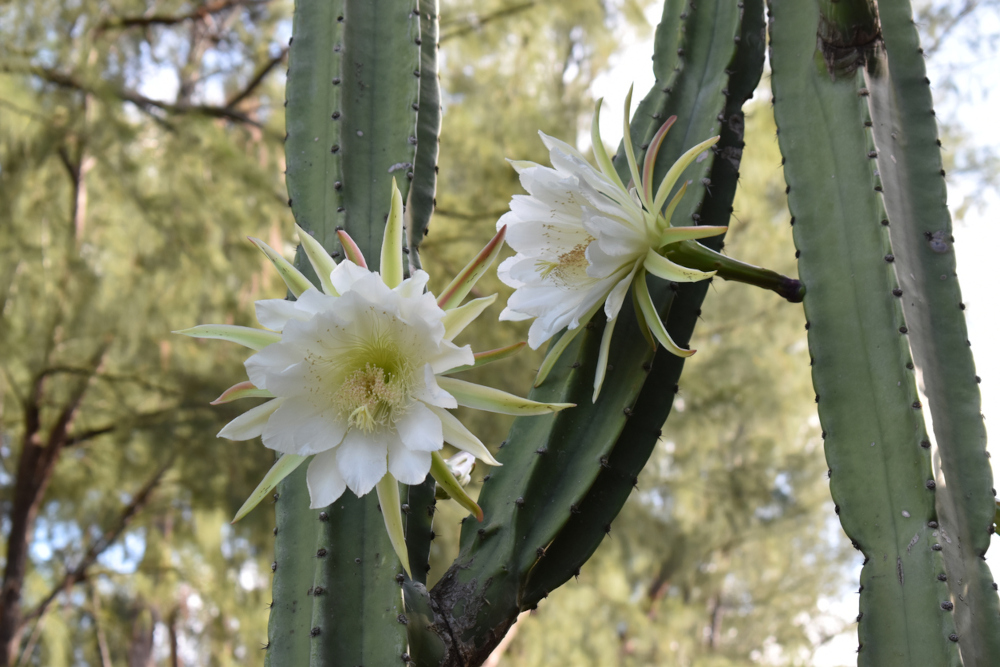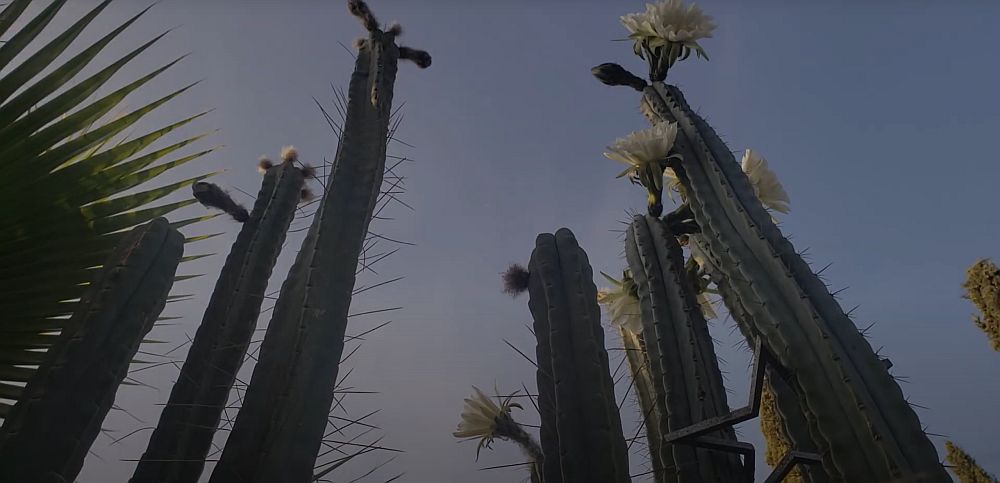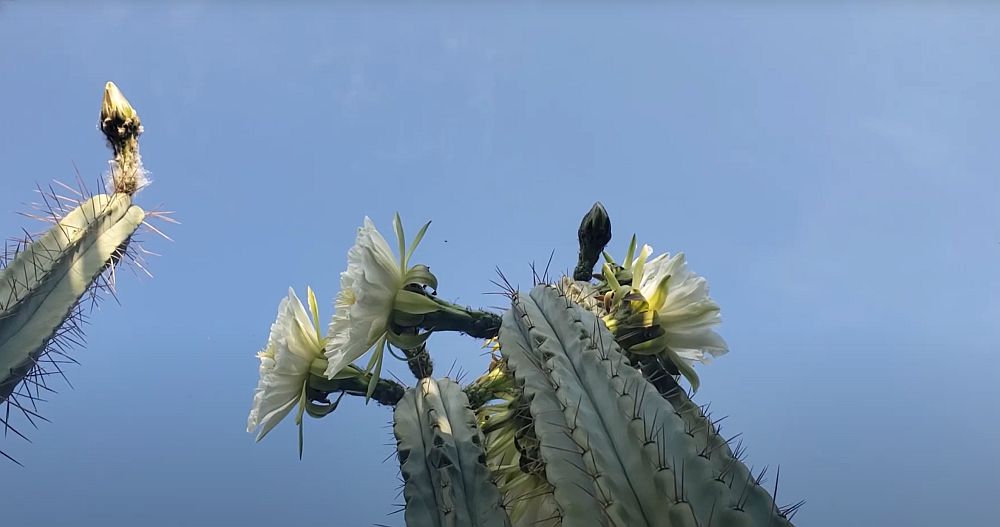San Pedro Cactus: Growing and Caring for the Trichocereus Pachanoi
The San Pedro cactus is the perfect plant for any green thumb. With its unique shape and vibrant colors, this ornamental cactus is sure to turn heads. But don’t be fooled – it may be pretty on the outside, but this plant is no pushover.
If you look around, you’ll find that the San Pedro cactus is, quite possibly, the most sought-after cactus variety.
Many gardening enthusiasts love to grow a plant that thrives with less and is minimal when it comes to the grooming routine. And it’s seemingly evident that this outdoor plant from the Echipnosis genus doesn’t disappoint.
Table of Contents
Keep reading to discover everything you need to know about growing and carrying for the Trichocereus pachanoi.
San Pedro Cactus Plant (Trichocereus Pachanoi or Echinopsis Pachanoi)
Anytime you walk into your nearby gardening retail store, you’ll probably find this plant labeled as Trichocereus pachanoi, Cereus pachanoi or Echinopsis peruviana (Peruvian torch cactus),but its scientific name is Echinopsis pachanoi(Spanish for The Cactus of Saint Peter).
It natively comes from a couple of countries in South America including Peru, Ecuador, Argentina, Bolivia, and Chile – that’s their natural habitat.
This plant ideally thrives when grown outdoors under USDA hardiness zones 8b through 10b and can endure frosting conditions. So you won’t need to give it the utmost attention during winter.
As it matures, the San Pedro cactus tends to resemble an upright pillar or column and grows up to 20 feet tall—which is equivalent to about 3 meters, hence why you might need to consider placing the medium on the outdoor space.
Over time, your fast growing columnar cactus from South America will turn into a small tree develop a few whitish areoles that produce 6-7 spines which are usually about 2 cm long. It sprouts a few stems that reach up to 6 feet in width and 20 feet in height.
Around mid-summer, the Trichocereus cactus produces white flowers, together with a few edible fruits. So if you’re planning to grow several cacti in your garden, you’d be lucky to harvest enough fruits to sell commercially.
How to Identify San Pedro Cacti
So you’re out there in the wild and you spot a San Pedro cactus, or so you think. How do you know for sure? Well, a few identifying features will help you determine if the columnar cactus in front of you is, in fact, an Echinopsis pachanoi.
First and foremost, these cacti have ribs. Lots and lots of ribs. They can be very distinguishable, especially on older specimens.
Secondly, the spines of this type of cactus are very thin and pointed. They’re also white, which can be helpful in distinguishing them from other types of cacti.
Finally, these strange cacti typically grow quite tall, often reaching 10-20 feet in height.
One particular trait of this cactus is that it often grows several stems from a single root system. So if you’re seeing a cactus with more than one stem, it’s likely a San Pedro.
If you’re still not sure after taking all of these factors into account, it never hurts to ask an expert.
San Pedro Cactus Care Tips
When caring for this type of cactus, you need to take the following conditions into account:
Soil & Transplanting
Your San Pedro needs well drained soil that is moderately acidic. You might want to add soluble fertilizer during summer to make the soil nutrient-rich. To fast-track its yield, it’s far more beneficial to use soil with organic material, preferably humus since it decomposes microorganisms that the plant takes in as nutrients.
When your plant is at its tender years, you want to highly dilute the fertilizer, so it doesn’t cause the soil to have excess salt concentration which coats the root hormones and ultimately stunts the overall growth.
However, an older cactus would do well even after using a fertilizer that’s mildly diluted. You’ll need to transplant your baby cactus to a bigger growing medium once it hits 1 year.
You can purchase cactus potting soil in gardening retail stores. This type of soil dries up so quickly and is ideal for succulents since they store moisture in their stems, pads, and trunks, so they can survive throughout the drought season. In simpler terms, this practically means that plant doesn’t need too much watering because it might ruin the entire rooting hormones.
Light & Temperature
As a drought tolerant plant, the San Pedro is, far and wide, tolerant to direct sunlight—not forgetting the fact that it’s native to the warmer regions of Peru and Ecuador.
But if the seedlings are exposed to full sun rays, they’ll begin to form brownish blemishes which are signs of sunburn and that would be hard to rectify.
If this happens, the only suitable remedy would be to start over with the germination process again.
It’s, therefore, far more fruitful to place it on a south-facing windowsill where the sunlight is a bit filtered, to protect it from any form of irreparable damage – light shade is ideal.
If you choose to fully grow it indoors, you want to use grow lights to enhance the photosynthesis process and level up the temperature it needs to grow healthy.
A mature San Pedro cactus plant can withstand temperatures as low as 15 °C, and if it mutates to the cold environment, it can steadily thrive even when surrounding conditions are below 5°C.
But during normal days, you want to keep your plant under warm temperatures, preferably above 50°C throughout the entire growing season.
If your cactus is turning dark green, it means that it’s not getting enough light. If it’s turning pale green, it might be too cold (even frost damage). However, pale green may also indicate mold growth due to poor ventilation conditions. Blue green means symbolizes perfect conditions.
Watering
Most succulents require fewer watering sessions when it’s winter. During this season, the rooting hormones freeze and become dormant, so they don’t absorb enough water like they do during hot summers.
So it can be grown indoors, although it’ll need frequent watering sessions when the cold temperatures disappear and it gets warmer. But if the roots are over watered for long hours, they begin to rot and this would eventually cause your San Pedro cactus plant to die.
Give the soil enough time to dry up completely before the next watering session.
Toxicity Levels
I guess you’re probably wondering whether San Pedro is toxic to pets and humans. This plant contains Mescaline—an alkaloid with hallucinogenic effects that harm the neural circuits in the brain. This suggests that the plant is slightly poisonous, so you want to keep it out of reach of kids.
Grooming & Maintenance
Same as other cacti plants, the Trichocereus pachanoi isn’t hard to sustain. If you want it to bolster up a few newer and fresh-looking stems, you need to trim the hedges and pluck off the withered parts occasionally, say, twice or three times every month. Since older plants sprout quite faster than the seedlings, trim it about 10 inches deep.
There’s nothing more you need to do apart from giving it the right amount of water after the grooming routine to help your plant rejuvenate its growth cells—except for winter since the hormones are usually numb during the freezing seasons.
While the San Pedro plant springs up, it becomes prone to diseases and pest attacks. As a remedy, you can use neem oil to get rid of pests leeching off of your plant’s foliage and yield.
Can You Propagate the San Pedro Cactus?
Yes, propagating a San Pedro cactus is possible.
Soon after your plant grows up to 3 meters tall, you’ll fancy having a couple more in your garden since you’ll love if for its pleasant aesthetic and potential to facelift your backyard’s landscape.
Propagating your Echinopsis pachanoi using seeds is, so far, the most effective method, compared to other options.
To get started, you’ll need these items:
- A mist spray bottle for plants
- Transparent airtight jars
- San Pedro cactus seeds not older than 2 years (buy from Kosmic Kitchen)
- Well-draining sandy soil mixed with pumice and coco coir
How to Propagate Using Seeds
Once you get hold of everything on the list above, these are the next steps that’ll help you carry out the whole propagation process and grow San Pedro from seed:
- Use a medium-size growing medium and fill the base level with potting soil mix.
- Make sure the soil is evenly distributed and gently squeeze the seeds through the soil.
- Mildly sprinkle water on the seedbed.
- Put the growing medium somewhere with filtered sunlight to prevent the seedlings from getting scorched; if it turns dark green, it means that it’s not getting enough light.
- If you want to grow your San Pedro cactus indoors, you need to buy grow lights that enhance the light spectrum which is essential for seedlings during their growth period. Hunt for one with at least 100 watts or more.
- The surrounding temperature should be anywhere between 25°C to 30°C.
- After about 2 to 3 weeks, the seeds will begin to germinate since this is the average yield period for most cacti plants.
- If you see any white or powder-like spots after this period lapses, that could be a sign your seedlings are infested with fungus gnats, and chances are they’ll die eventually.
- You also need to be careful not to buy low-quality seeds since they die off—regardless of whether you’ll make efforts to give them the most suitable growing conditions. The bottom line is you need to purchase your seedlings from reputable gardening retailers in the market.
- Typically, you can propagate your cactus when it’s almost 1 year old, precisely during summer. Newer seeds make sturdier Trichocereus pachanoi plants, so you need to check how old they are before getting started with the propagation process.
How to Propagate Using Cuttings
One of the best ways to propagate this columnar species is by taking San Pedro cuttings.
Here’s how you can go about cutting this cactus without too much effort:
- First, cut off a healthy stem from the cactus. It’s important to make sure that the stem is healthy and has plenty of buds.
- Cut the stem into 3-4 inch pieces.
- Remove the spines from the cuttings using a sharp knife or scissors.
- Lay the cuttings in a dry place and wait for them to callous over (this usually takes a few days).
- Once the cuttings have been calloused over, you can plant them in a pot or soil.
It’s also possible to propagate San Pedro cacti by taking root cuttings, but this is a little more complicated and isn’t covered extensively in this article.
However, we’ll give you the short version:
- Take a cutting from a healthy, established Echinopsis pachanoi cactus.
- Remove the spines from the cutting and place them in a pot or soil.
- Keep the pot in a sunny location and water regularly during a warm season.
- After a few weeks, you should start seeing new cutting growth.
How to Replant San Pedro Cactus
If you’ve had your cactus for a while and it’s starting to get a little crowded in its pot, it’s time to re-plant it. Here’s how:
- First, remove the cactus from its pot.
- Then, use a sharp knife or scissors to cut away any dead or rotting tissue from the cactus.
- Next, re-pot the cactus in a pot that’s one size larger.
- It’s important to use a pot that has drainage holes so the cactus can drain properly.
- Finally, water the cactus well and place it in a sunny location.
Trichocereus pachanoi like plenty of sun and good drainage, so make sure to keep that in mind when re-potting.
How to Dry San Pedro Cactus
One of the great things about these cacti is that they can be dried easily and stored for long periods of time. Here’s how you do it:
- First, cut the cactus into small pieces using a sharp knife or scissors.
- Next, lay the pieces out on a baking sheet and bake at a low temperature (175 degrees Fahrenheit) for 12-24 hours.
- Once the cactus is dried, you can store it in a cool, dry place for up to 1 year.
Drying San Pedro cacti is a great way to preserve them for long periods of time. You can also use the dried cactus in teas, tinctures, and other preparations.
You can also skip the oven part and dry the cactus using a food dehydrator. If you don’t have one, there’s also the possibility of drying the cactus in the sun.
Just be sure to keep an eye on it and make sure it doesn’t get too hot. You’ll also want to make sure the cactus is completely dry before storing it.
Without drying it up completely, trying to store it could lead to mold and other problems.
Common Pests & Diseases That Damage the San Pedro Cactus
Like other cacti plants, the San Pedro is prone to a few pest attacks and diseases that often catch most succulents.
Almost every variety in the Echinopsis pachanoi species is vulnerable to various strains of fungal diseases. One common symptom you might spot is the rotting of stems.
You’ll also probably have to deal with mealybugs, root aphids, and spider mites. To get rid of such pests, you can start off with a natural pesticide such as neem oil, especially if your cactus isn’t mature enough.
Black Spots
Unfortunately, San Pedro cacti can be susceptible to black spots, which are caused by a fungus. The good news is that black spots are not usually fatal to a cactus and can be treated.
If you notice black spots on your cactus, don’t panic! Here’s what you can do:
- Remove any dead or rotting tissue from the cactus using a sharp knife or scissors.
- Apply a fungicide to the cactus. There are many different types of fungicides available, so be sure to read the instructions carefully.
- Keep the cactus in a dry place with good air circulation.
- If the black spots don’t go away after a few weeks, you may need to take additional steps to remove the entire cactus and repot it in fresh, dry soil.
And that’s all there is about black spots on Echinopsis pachanoi!
San Pedro Cactus (FAQ)
Find out more details about this amazing cactus:
How often does the San Pedro cactus flower?
The fragrant flowers sporadically, usually during the spring or summer months. You can keep track of the flowering process by looking for new buds.
Is San Pedro legal to grow?
Yes, the Echinopsis pachanoi is legal to grow in most countries. However, you should always check with your local authorities to make sure it’s legal to grow this particular type of cactus in your area.
Why is my cactus leaning?
It’s common for cacti to lean over due to the weight of the spines and the fact that they grow in a spiral shape. You can help keep your cactus upright by using stakes or dowels to prop it up. However, note that cactus leaning is not strictly related to San Pedro.
What’s the best soil for San Pedro?
Good soil for San Pedro cactus is a sandy, loamy mix that has plenty of organic matter. Make sure the pot has drainage holes so the cactus can drain properly. Place a layer of gravel or broken pottery in the bottom of the pot to help with drainage.
How fast does the San Pedro cactus grow?
The Echinopsis pachanoi can grow anywhere from 1-4 inches per week. However, it’s important to note that this rate of growth can vary depending on the climate and other factors.
Should I fertilize my San Pedro cactus?
No, you should not fertilize your Echinopsis pachanoi. It’s important to note that cacti don’t require a lot of fertilizer and over-fertilization can actually be harmful.
What’s the best way to water my San Pedro cactus?
It’s important to water your San Pedro cactus regularly, but you don’t want to over-water it. Water the plant well and allow the soil to dry out between waterings. These cacti like lots of sun and good drainage, so make sure to keep that in mind when re-potting.
Conclusion
All things considered, if you’re looking for a cactus that’s easy to grow for ornamental purposes, the Trichocereus pachanoi is a good option.
It’s tolerant of a wide range of temperatures and soil conditions, and it flowers intermittently throughout the year – it’s why many people prefer it. Just be sure to give it plenty of sun and drainage, and water it well.
Widely grown around the world, San Pedro cacti make great additions to any garden or collection, and they’re a great way to learn about cactus care.
